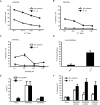IL-12 enhances CTL synapse formation and induces self-reactivity
- PMID: 19155481
- PMCID: PMC2630174
- DOI: 10.4049/jimmunol.182.3.1351
IL-12 enhances CTL synapse formation and induces self-reactivity
Abstract
Immunological synapse formation between T cells and target cells can affect the functional outcome of TCR ligation by a given MHC-peptide complex. Although synapse formation is usually induced by TCR signaling, it is not clear whether other factors can affect the efficiency of synapse formation. Here, we tested whether cytokines could influence synapse formation between murine CTLs and target cells. We found that IL-12 enhanced synapse formation, whereas TGFbeta decreased synapse formation. The enhanced synapse formation induced by IL-12 appeared to be functional, given that IL-12-treated cells could respond to weak peptides, including self-peptides, to which the T cells were normally unresponsive. These responses correlated with expression of functionally higher avidity LFA-1 on IL-12-treated CTLs. These findings have implications for the function of IL-12 in T cell-mediated autoimmunity.
Figures






Similar articles
-
Defective CD8+ T cell activation and cytolytic function in the absence of LFA-1 cannot be restored by increased TCR signaling.J Immunol. 1999 Nov 1;163(9):4826-32. J Immunol. 1999. PMID: 10528183
-
The strength of T cell receptor signal controls the polarization of cytotoxic machinery to the immunological synapse.Immunity. 2009 Oct 16;31(4):621-31. doi: 10.1016/j.immuni.2009.08.024. Immunity. 2009. PMID: 19833087 Free PMC article.
-
PIP5 Kinases Regulate Membrane Phosphoinositide and Actin Composition for Targeted Granule Secretion by Cytotoxic Lymphocytes.Immunity. 2018 Sep 18;49(3):427-437.e4. doi: 10.1016/j.immuni.2018.08.017. Epub 2018 Sep 11. Immunity. 2018. PMID: 30217409 Free PMC article.
-
The synapse and cytolytic machinery of cytotoxic T cells.Curr Opin Immunol. 2010 Jun;22(3):308-13. doi: 10.1016/j.coi.2010.02.008. Epub 2010 Mar 11. Curr Opin Immunol. 2010. PMID: 20226643 Free PMC article. Review.
-
The cytotoxic T lymphocyte immune synapse at a glance.J Cell Sci. 2016 Aug 1;129(15):2881-6. doi: 10.1242/jcs.186205. J Cell Sci. 2016. PMID: 27505426 Review.
Cited by
-
Tumor-specific CD8+ T cells expressing interleukin-12 eradicate established cancers in lymphodepleted hosts.Cancer Res. 2010 Sep 1;70(17):6725-34. doi: 10.1158/0008-5472.CAN-10-0735. Epub 2010 Jul 20. Cancer Res. 2010. PMID: 20647327 Free PMC article.
-
IL-12 and GM-CSF in DNA/MVA immunizations against HIV-1 CRF12_BF Nef induced T-cell responses with an enhanced magnitude, breadth and quality.PLoS One. 2012;7(5):e37801. doi: 10.1371/journal.pone.0037801. Epub 2012 May 24. PLoS One. 2012. PMID: 22655069 Free PMC article.
-
Novel mucosal DNA-MVA HIV vaccination in which DNA-IL-12 plus cholera toxin B subunit (CTB) cooperates to enhance cellular systemic and mucosal genital tract immunity.PLoS One. 2014 Sep 12;9(9):e107524. doi: 10.1371/journal.pone.0107524. eCollection 2014. PLoS One. 2014. PMID: 25215887 Free PMC article.
-
T cells and stromal fibroblasts in human tumor microenvironments represent potential therapeutic targets.Cancer Microenviron. 2010 Mar 31;3(1):29-47. doi: 10.1007/s12307-010-0044-5. Cancer Microenviron. 2010. PMID: 21209773 Free PMC article.
-
Manipulating the TCR signaling network for cellular immunotherapy: Challenges & opportunities.Mol Immunol. 2020 Jul;123:64-73. doi: 10.1016/j.molimm.2020.04.007. Epub 2020 May 15. Mol Immunol. 2020. PMID: 32422416 Free PMC article. Review.
References
-
- Hemmer B, Gran B, Zhao Y, Marques A, Pascal J, Tzou A, Kondo T, Cortese I, Bielekova B, Straus SE, McFarland HF, Houghten R, Simon R, Pinilla C, Martin R. Identification of candidate T-cell epitopes and molecular mimics in chronic Lyme disease. Nat Med. 1999;5:1375–1382. - PubMed
-
- Hemmer B, Pinilla C, Appel J, Pascal J, Houghten R, Martin R. The use of soluble synthetic peptide combinatorial libraries to determine antigen recognition of T cells. J Pept Res. 1998;52:338–345. - PubMed
-
- Mason D. A very high level of crossreactivity is an essential feature of the T-cell receptor. Immunol Today. 1998;19:395–404. - PubMed
-
- Kersh GJ, Allen PM. Essential flexibility in the T-cell recognition of antigen. Nature. 1996;380:495–498. - PubMed
Publication types
MeSH terms
Substances
Grants and funding
LinkOut - more resources
Full Text Sources
Other Literature Sources
Molecular Biology Databases
Research Materials

